Ask any experienced plant owner, and they will tell you something similar. We have all encountered at least one houseplant that simply wasn’t cut out for our space or lifestyle. Call it survival of the fittest; some just can’t hack it in every environment. But other houseplants much more forgiving and easy to care for.
If you’re just getting started or trying again after a mishap, you’re certainly not alone. It’s hoyas for me. No matter what I do, I can’t seem to keep them growing indoors. They have to live outside during the summer at my house. Others find these to be easy as pie.
When it comes to keeping houseplants alive, it typically comes down to two factors: care and environment. Let’s talk for just a minute about what that means. Then, I have some plants to tell you about that tend to be resilient and forgiving, even under less-than-ideal circumstances.
Water
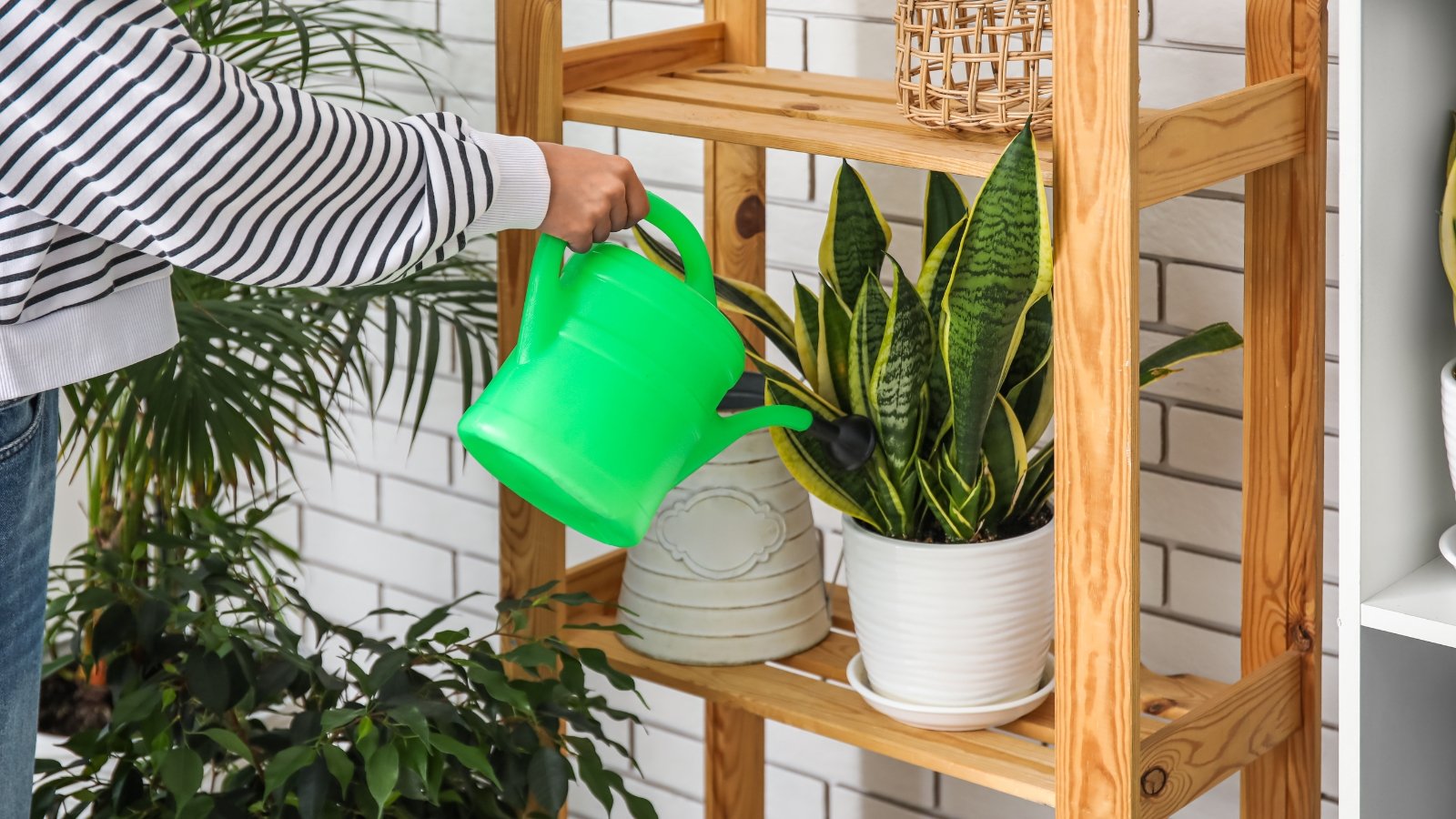
The number one killer of houseplants is water. Watering seems like such a simple thing. Every living thing needs water to survive. Plants are living; they need water, so we give it to them, right? It’s a bit more complicated than that.
Depending on the native environment of your specific cultivar, watering needs differ drastically. Many are tropicals, which have very specific needs, and others may be succulents, which require something altogether different when it comes to moisture.
Ironically, underwatering is not usually the killer. It’s most often overwatering. It’s easy to overwater when we use containers without drainage. These containers make watering easier because it won’t spill out all over the house, but they hold that moisture much longer as a result.
Many plants will develop root rot and other fungal diseases if they constantly have wet roots. If you use pots with no drainage, you’ll need to pay closer attention to the moisture in the soil and water less frequently.
An alternative is to keep plants in plastic pots with drainage holes set inside your decorative containers. When it’s time to water, remove the pots and water. Then, allow the water to drain out of the container before replacing it.
Light
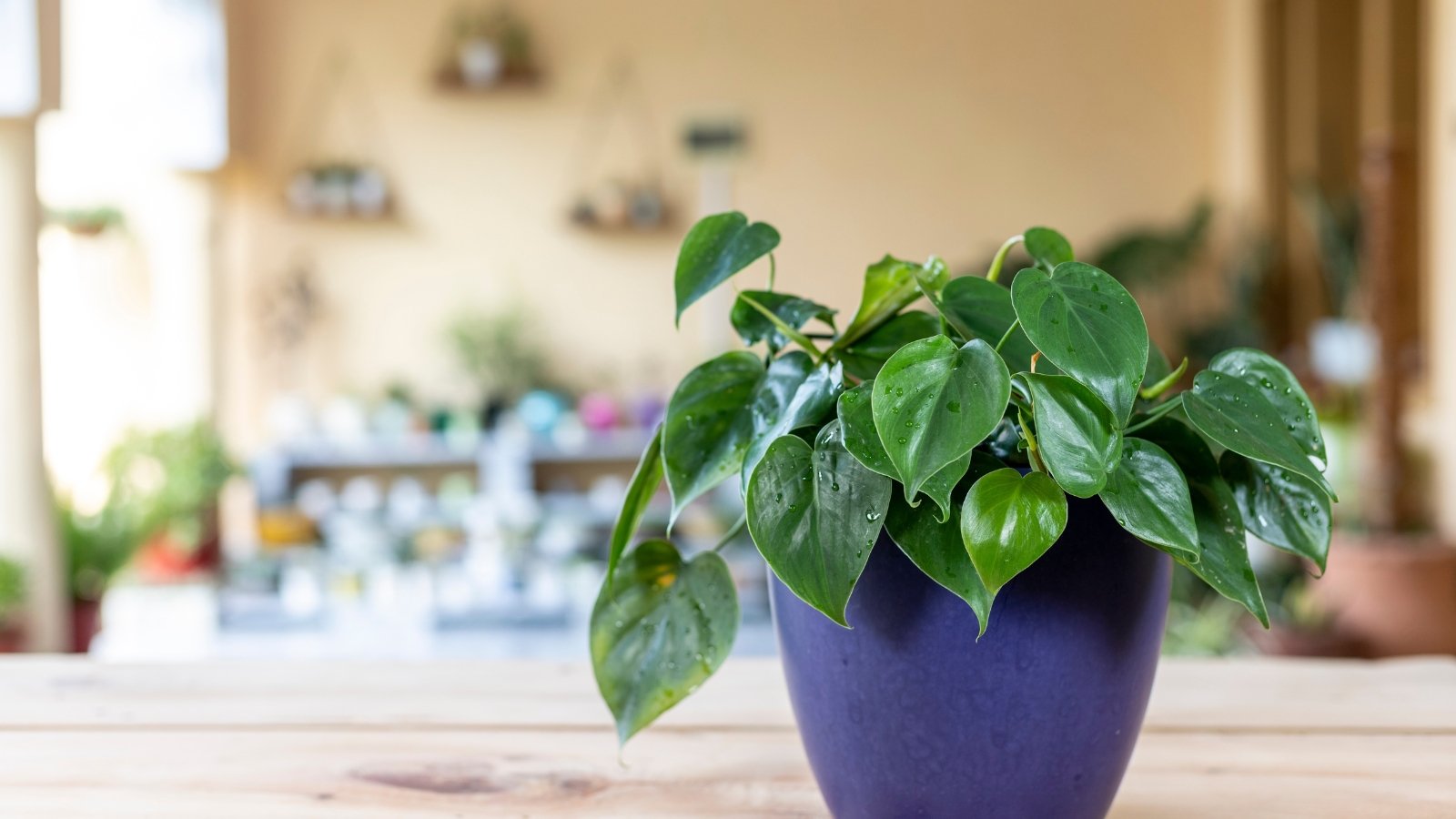
I keep most of my houseplants in a few forgiving spaces of my home where they are easy to take care of: my bathroom windows, my kitchen windows, and one other brightly lit room. While many houseplants tolerate what we call ‘low light,’ none will survive without some exposure.
A few things need to stay out of direct sun. Some orchids, a few succulents, and a couple of others prefer no direct exposure at all. Most of the plants we keep indoors need a long period of bright, indirect exposure.
Sunlight is how plants produce chlorophyll. Chlorophyll is food, and without it, they cannot live. It’s important to understand how much light you have to offer and purchase cultivars that fit that specification.
If your plant grows leggy, with leaves farther apart than they ought to be, it needs more sun. The same applies to those that seem to lean or turn all of their leaves toward the nearest light source. Likewise, droopy, bleached, or burned leaves are getting more than they need.
Humidity
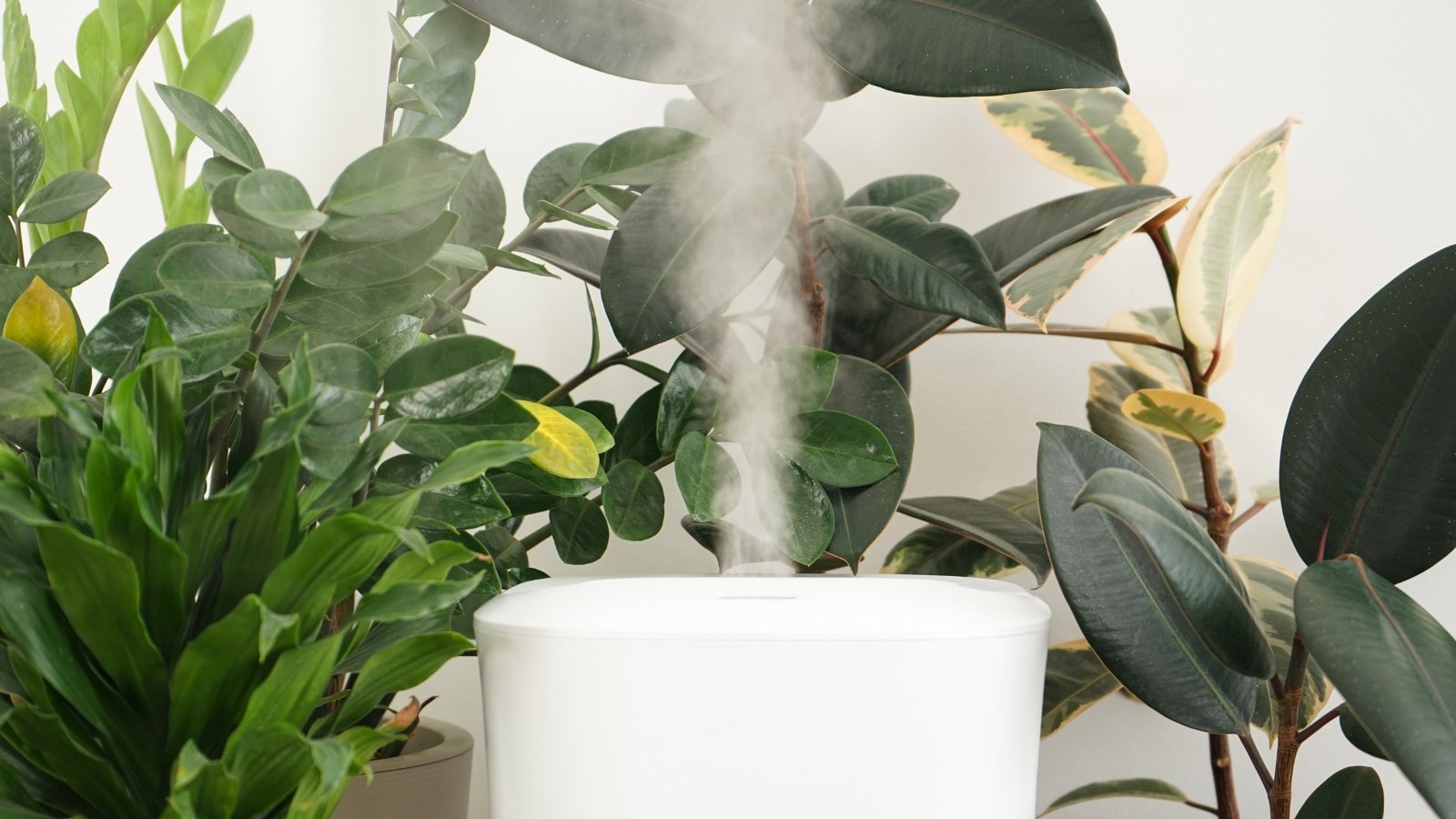
This final factor is a tough one and one that is often overlooked. I mentioned that my bathroom and kitchen windows are the primary spots where I keep my plant babies. There is a simple reason for this.
We established that many houseplants are tropical. Tropical rainforests are humid, and these have adapted to thrive in humid conditions. Without it, their leaves will dry out and turn brown at the tips. They may survive, but they won’t grow to their full potential.
Humidity is especially important for orchids. They take in a lot of moisture from the air through their leaves and aerial roots. They are also highly susceptible to root rot and other fungal issues. If you over-water to compensate for a lack of humidity, your orchid won’t last long.
There are other solutions to the humidity issue. In many cases, you can use a pebble tray. A humidifier is useful if you have many that need humidity in close proximity.
ZZ Plant
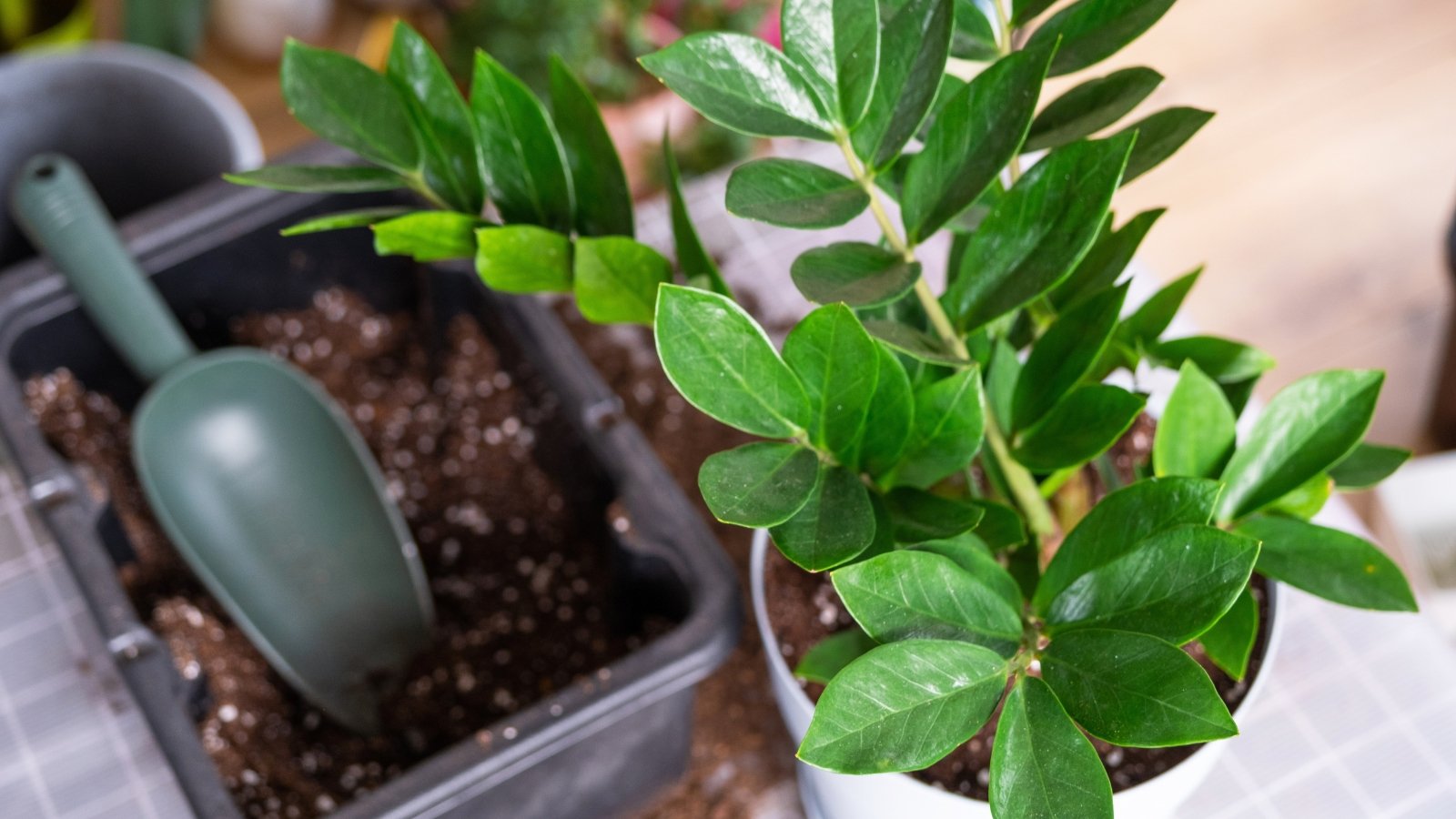
You’ve probably heard of or even seen a ZZ plant, possibly in a hardware store or even a local supermarket. These are incredibly popular, and the reason is simple. They are easy to care for and resilient during an adjustment period. Native to East Africa, these are adapted to warm climates.
Your ZZ doesn’t need much care, so it’s a great one to start with. Be careful about overwatering; it prefers to dry between waterings. In terms of light, bright and indirect are good rules to follow. It will tolerate lower exposure conditions than many, but it will grow slower with less light.
Snake Plant
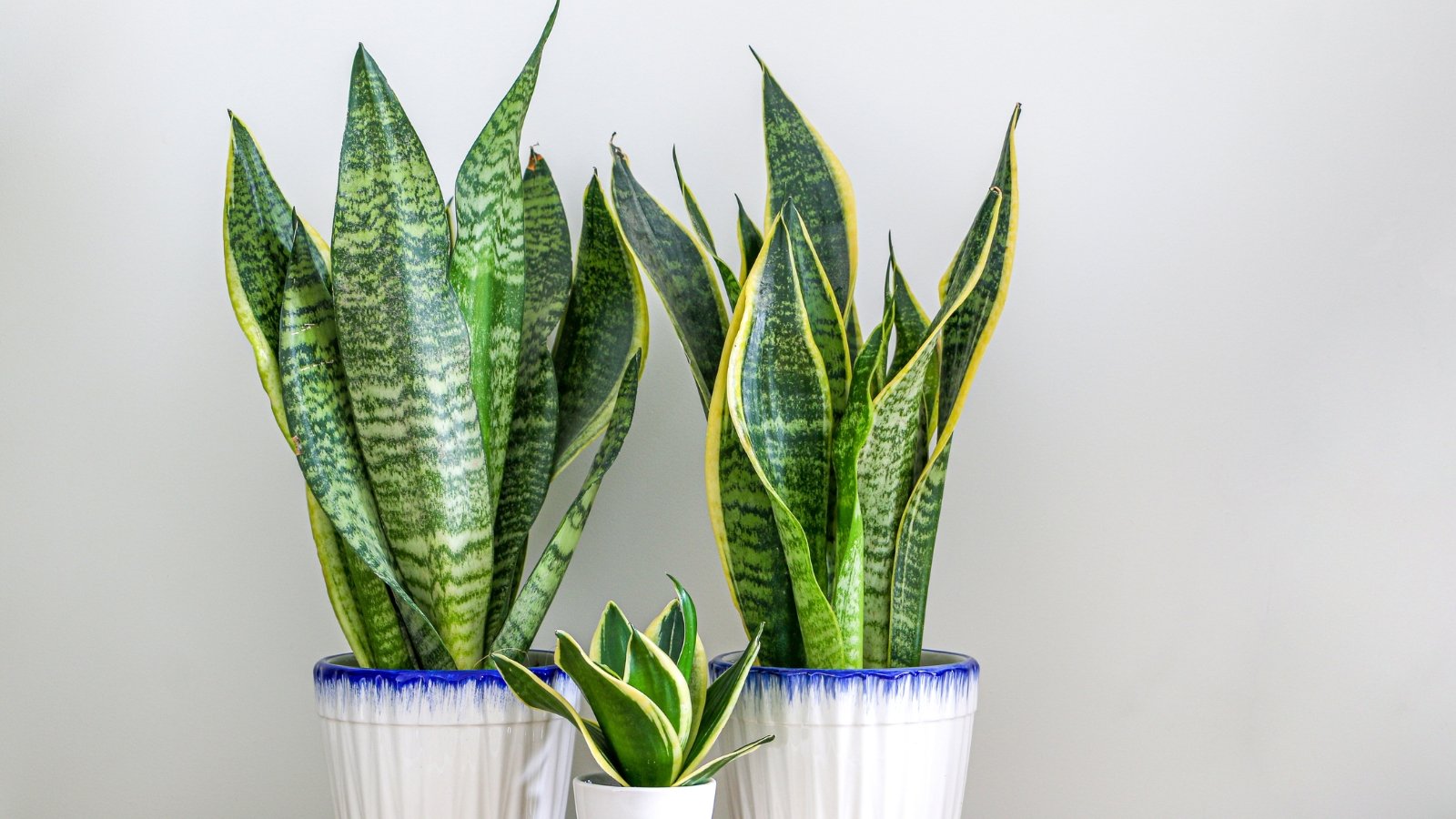
Snake plants are famous easy-care houseplants that are very forgiving, except with overwatering. I will start with the disclaimer that I have watered this one to death. I can safely say that overwatering is the best way to kill a snake plant. To keep it happy, treat this one more like a succulent. Make sure to use loose soil and a container with drainage.
In terms of light, this will tolerate lower exposure situations better than most. It will grow faster with increased exposure. If you have a habit of neglecting your plants, this one is perfect. It can go long periods with little water and low light conditions. It’s happy with normal indoor humidity levels.
Heartleaf Philodendron
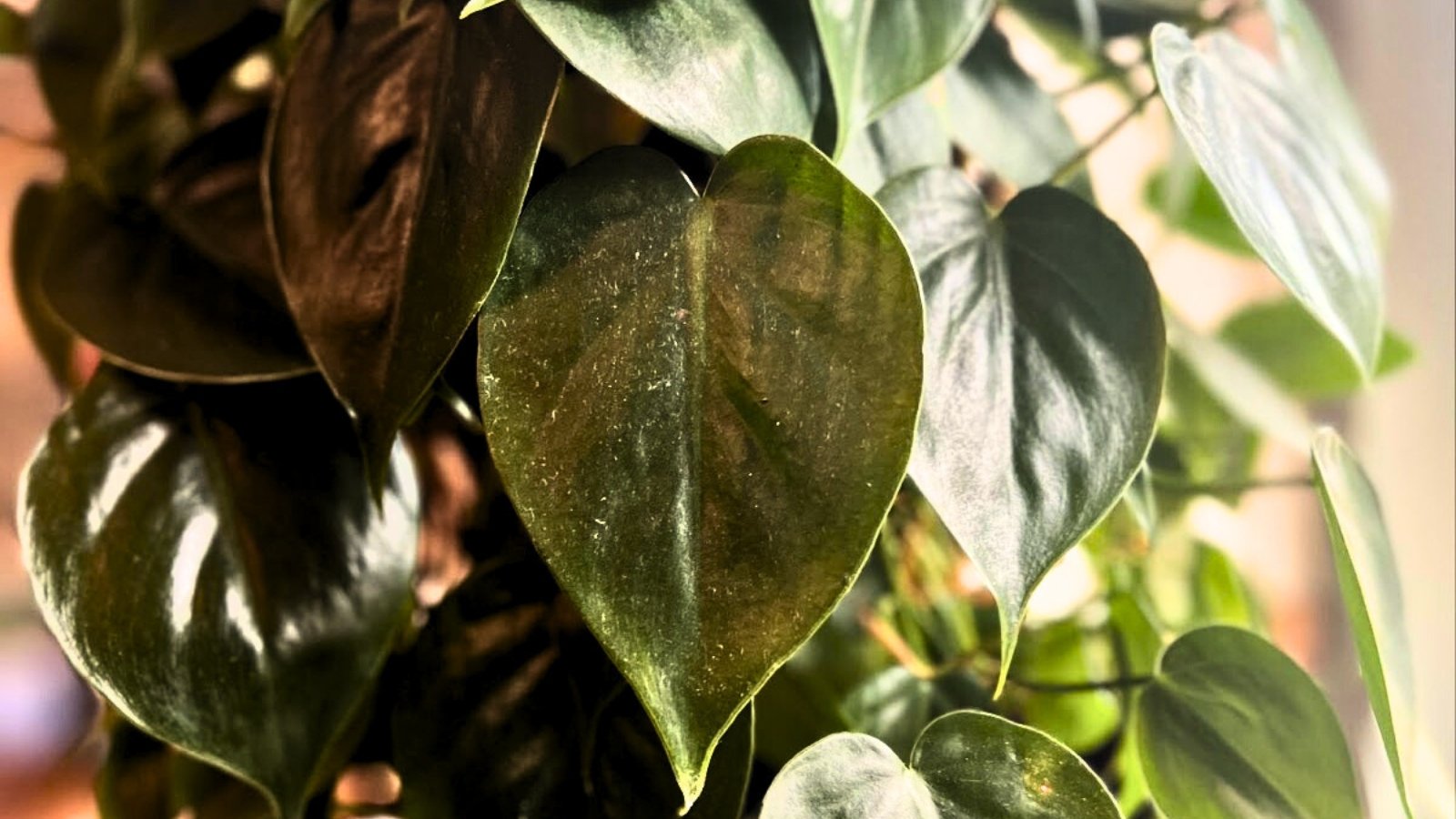
Philodendrons are tropical, and some species are fussy about care. Heartleaf is not difficult though, and makes a great beginner specimen. As you can see in the photo, mine is happily hanging in my kitchen window, which is Southwest facing. It gets indirect light all day, with a few hours of direct sun in the afternoon. Hanging above the sink gives it a humidity boost, which it loves.
Heartleaf has wonderful, soft, heart-shaped leaves and loves the occasional haircut. It roots easily in water, so you’ll always have some to share or move to a different spot in the home. Philodendrons are flexible with watering. They are fine to dry between waterings, but lightly moist soil is preferable. Just don’t keep them soggy, or they will rot.
Silver Satin Pothos

Silver satin pothos are not true pothos, but they have similar appearance and care needs. Its stunning silvery markings make it popular. This one hangs next to my heartleaf philodendron, which is quite content with bright light all day and just a bit of direct sun in the afternoon.
It’s mostly indifferent to humidity. I have one in my closet window, and it’s happy there as well. I do live in Florida, though, so it’s always on the humid side, comparatively. Silver satin likes to dry between waterings and will let you know by drooping if you’ve let it get too thirsty. Watering will make it bounce back.
African Violet
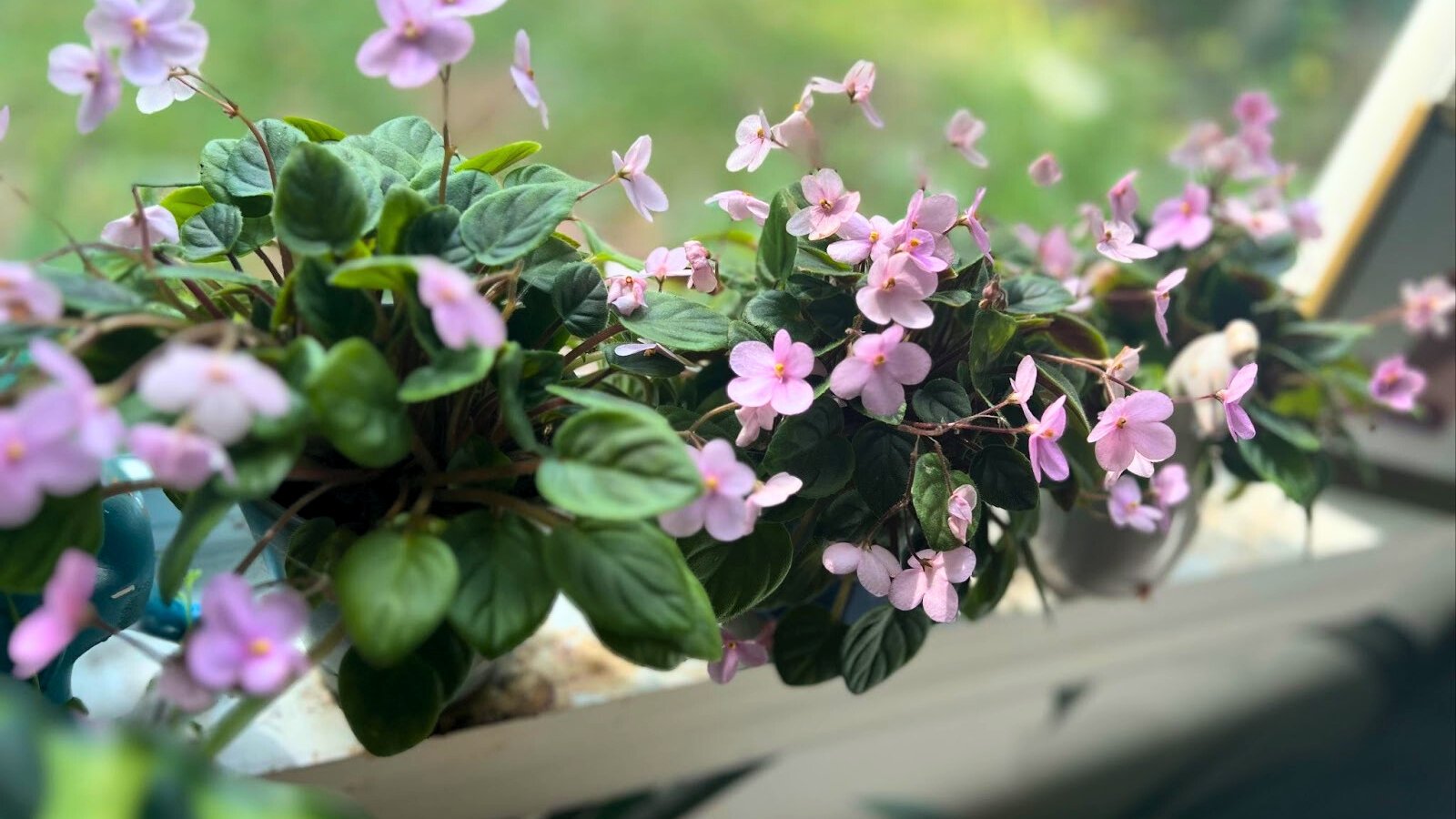
African violets won’t appear on every list of easy-care houseplants because they are not forgiving about moisture. But if the conditions are right, they are low-maintenance. The plants you see pictured came from a single specimen in a two-inch pot about three years ago. I give them a lot of light and pots that drain, and they reward me by multiplying faster than I can divide them!
Because they prefer to be slightly root-bound, I keep mine in small containers and water often. They like moist soil, and if it dries out, they will let you know by drooping. A bit of fertilizer goes a long way for African violets. If they are happy, they will bloom nearly year-round.
Pothos ‘Pearls & Jade’
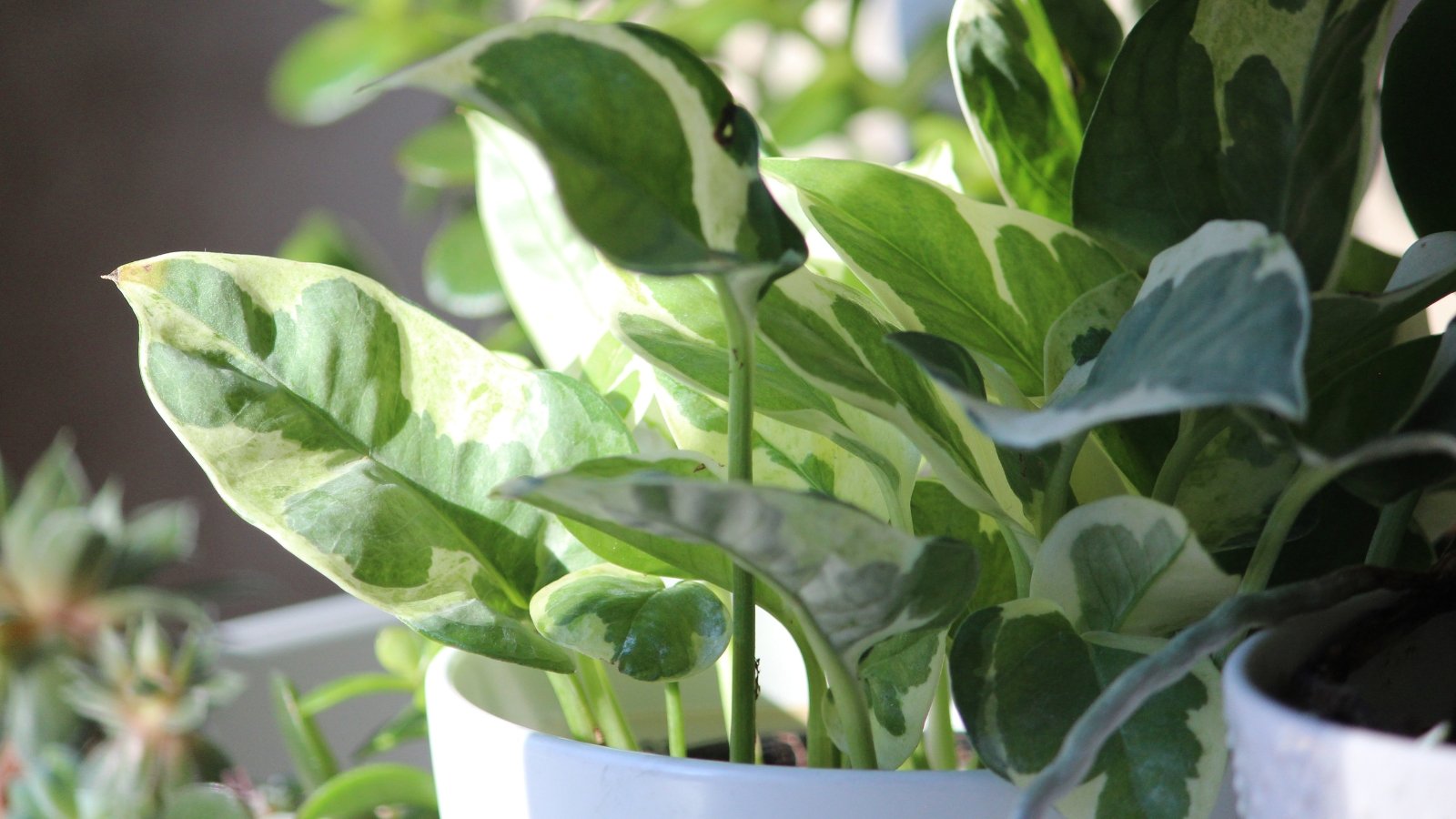
Pothos are notoriously easy to care for, forgiving, and resilient houseplants. No matter the variety, the care is the same. They tolerate nearly any light condition and are flexible about watering. It’s better to underwater than overdo it, this will help avoid root rot.
There is no easier plant to propagate; cuttings root easily in water. Pearls & Jade is a beautiful variety with variegated leaves in blue-green and creamy white. Some direct light is fine, but indirect is best. They will grow faster with more but are exceptionally tolerant of low light.
Monstera
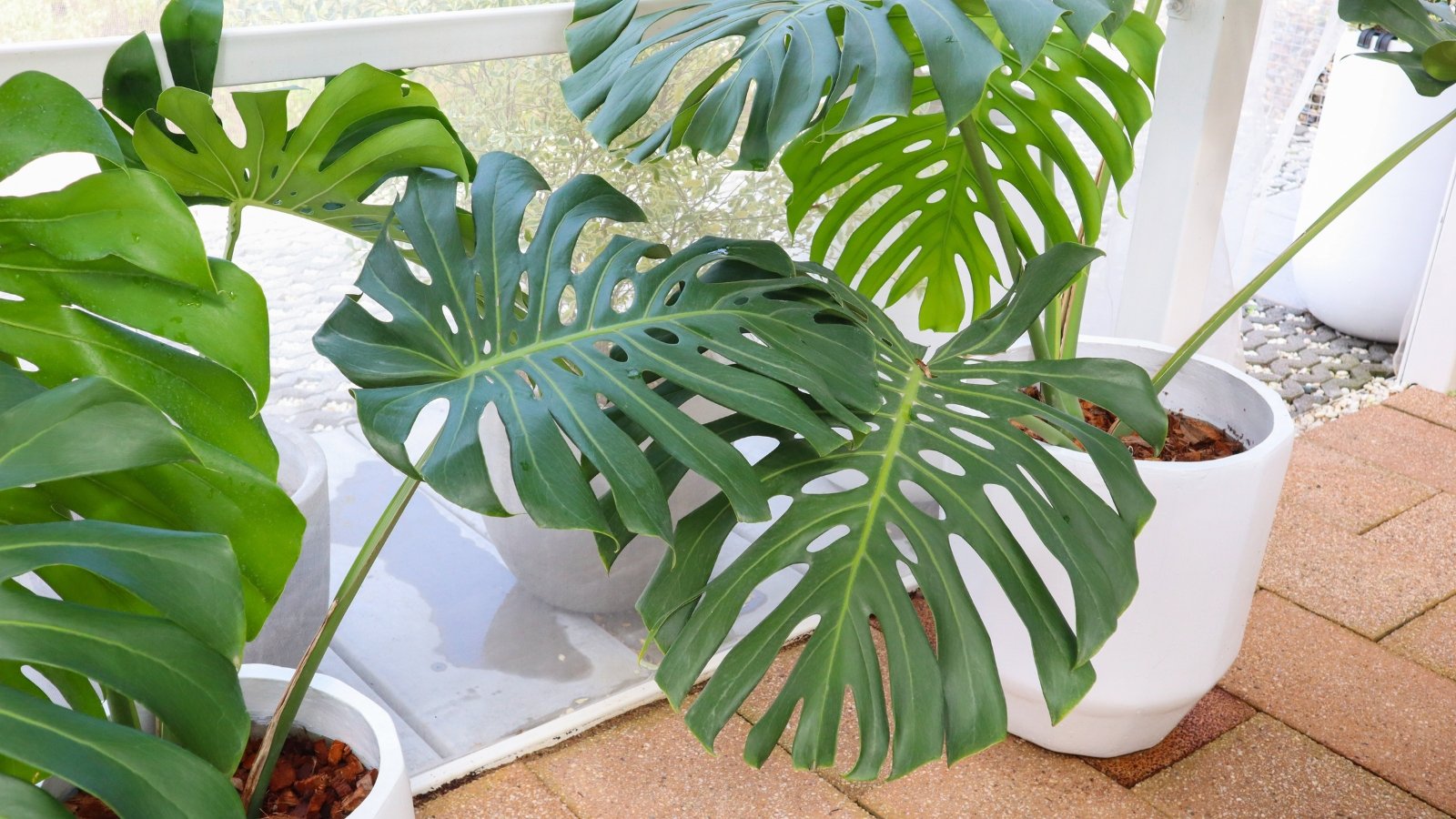
Monsteras are popular for their large, showy leaves and easygoing nature. You get a lot of plant for little work with this one. It prefers to climb, so give it a moss pole to hold onto. You’ll know your monstera is happy by how quickly it grows. It should begin to put out a new leaf about four to six weeks after the last leaf unfurls.
Give your monstera a lot of bright light. Mine sits beside a bright window and leans in for more sun during the cooler months. The direct sun is too harsh in summer, so I use a light-filtering shade. Let the soil dry between waterings, but keep an eye on it. The soil will dry faster than expected as this large plant is thirsty. Do not let this one wilt.
Haworthia
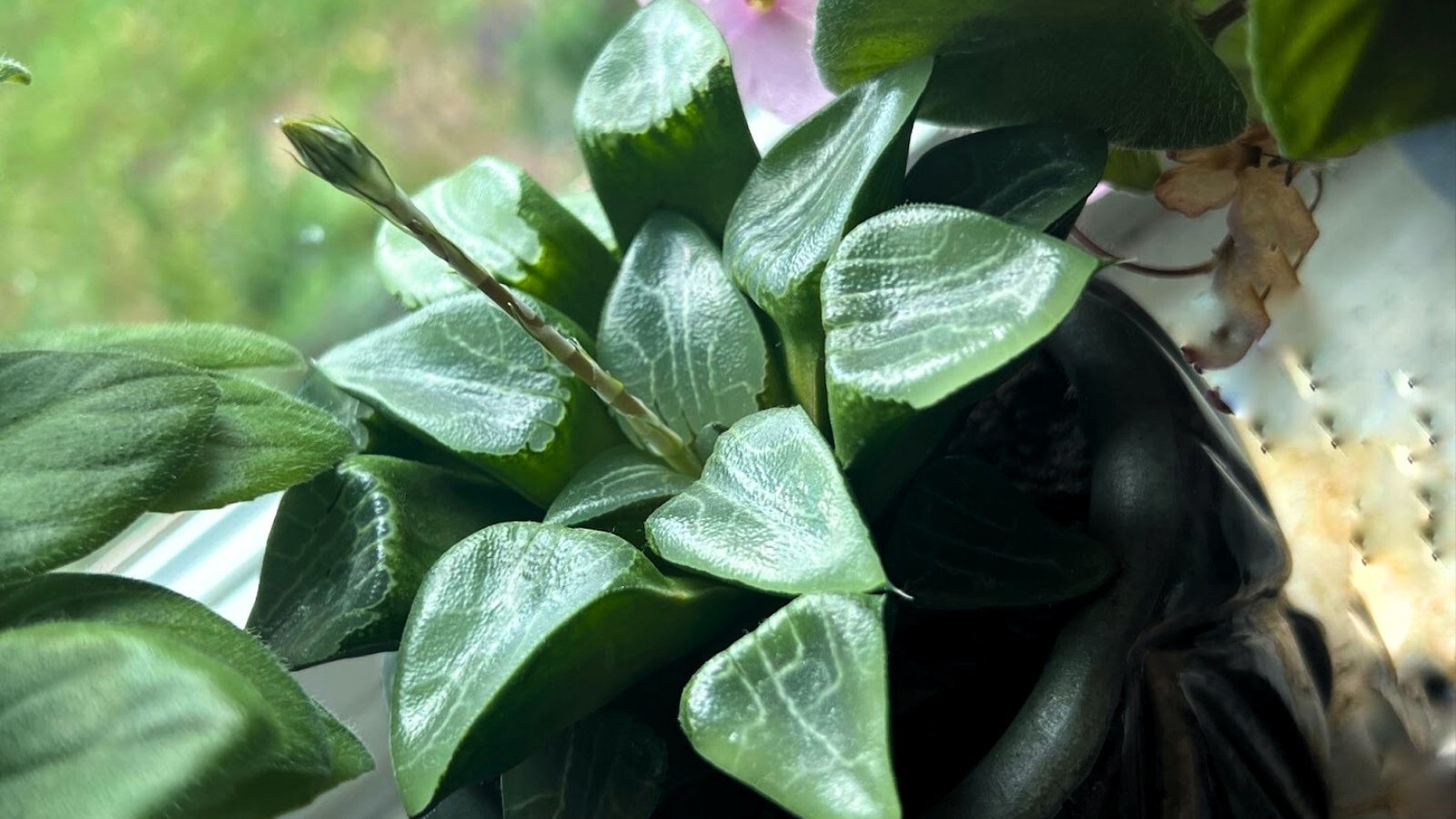
Many varieties of haworthia make delightfully forgiving houseplants. They are small, slow-growing succulents that tolerate partial shade or bright indirect light. Mine is happy sitting beside my African violets, though it needs far less water.
Fleshy, succulent leaves hold plenty of moisture reserves, so don’t keep the soil consistently moist. Allow it to dry out. It can remain dry for several days or more. If they get more light, haworthias will flower. Because it grows so slowly, and remains relatively small, this makes a great windowsill plant.
Flamingo Flower
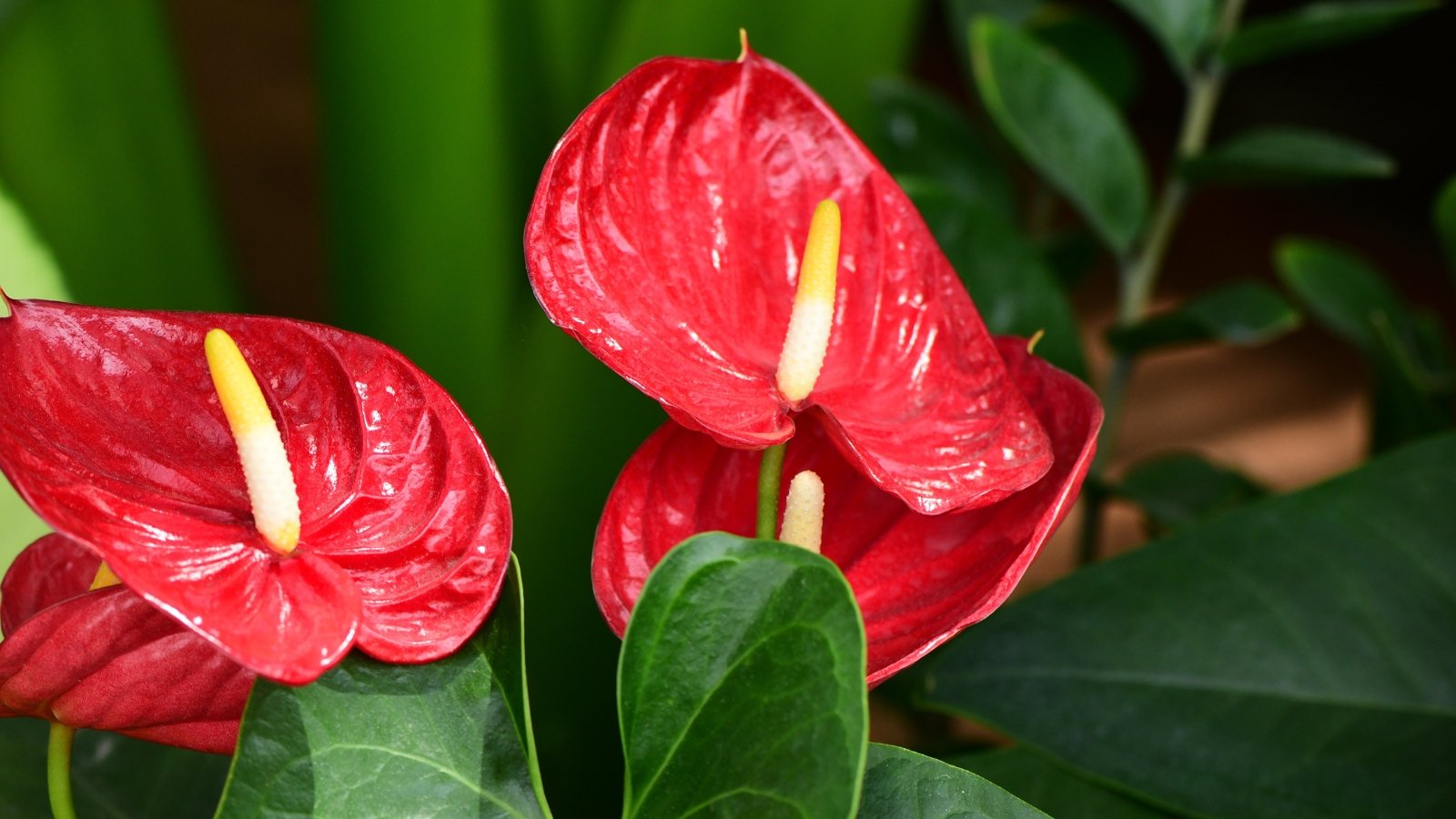
The Flamingo flower is a type of anthurium, which can be fussy depending on the species. This particular one is fairly easy, and they are easy to find because they are so popular. This is an epiphyte in its native environment. It grows on trees without soil. Make sure to pot it with a coarse potting mixture with bark added, and a container with good drainage.
Anthuriums need plenty of bright light, but direct sunlight will burn the leaves. They appreciate high humidity and need their roots to dry between waterings. It’s easy to over-water these because they are epiphytes. If they are happy, they will reward you with flamboyant flowers that last a long time.
Spider Plant
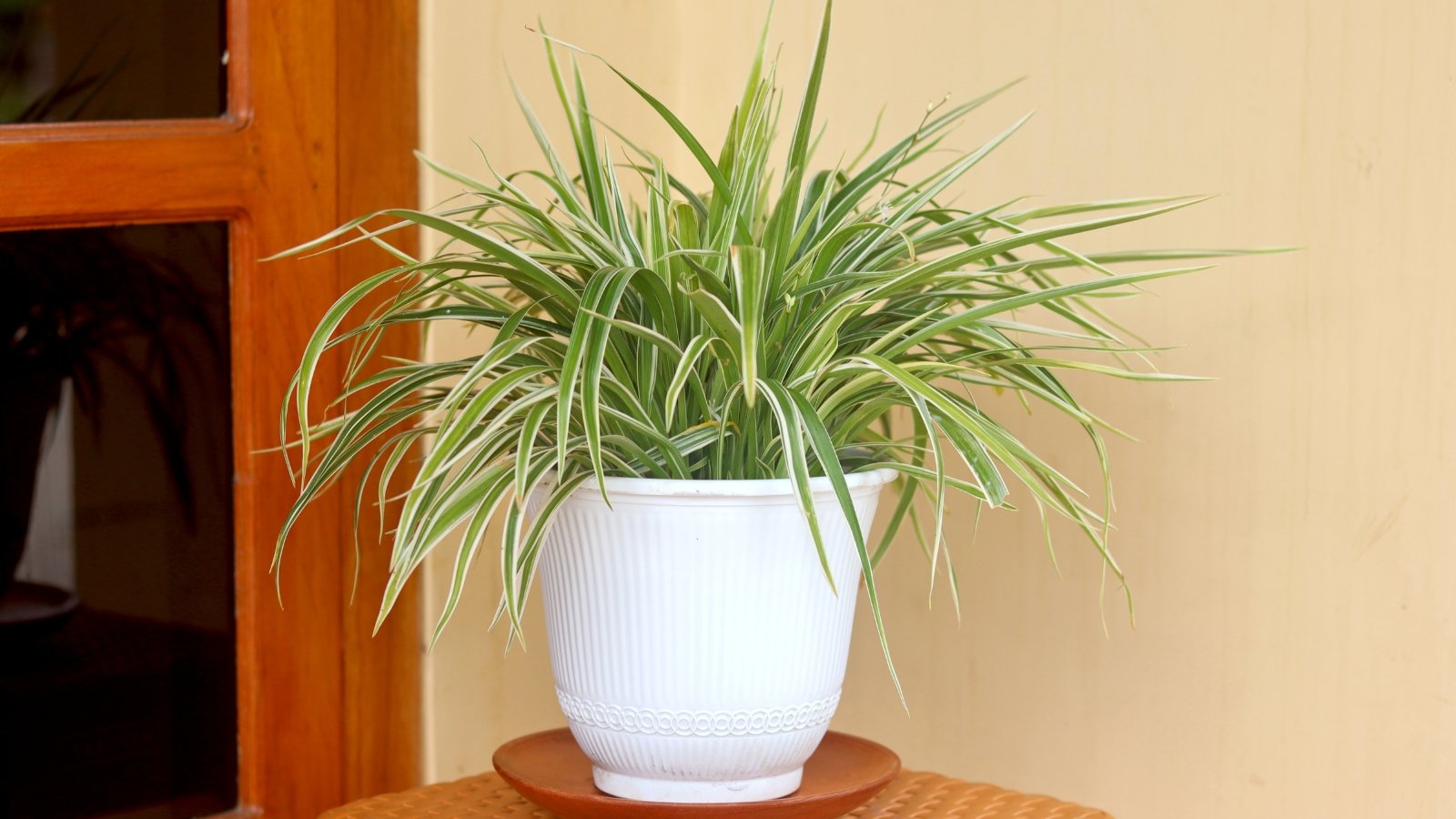
Spider plants are great bathroom specimens, as they thrive in high-humidity environments. They will tolerate moderate levels, but they won’t produce as many of those adorable little offspring. Water only when the top of the soil is dry. You’ll need to water more in the spring and summer and less in the winter.
In terms of light, spider plants like a lot of it, but not direct exposure. Keep it just out of the direct sun. You’ll know if your spider is getting enough light if the variegation is crisp and pronounced. Too little, and there won’t be as much contrast between the green and white.
Rubber Fig
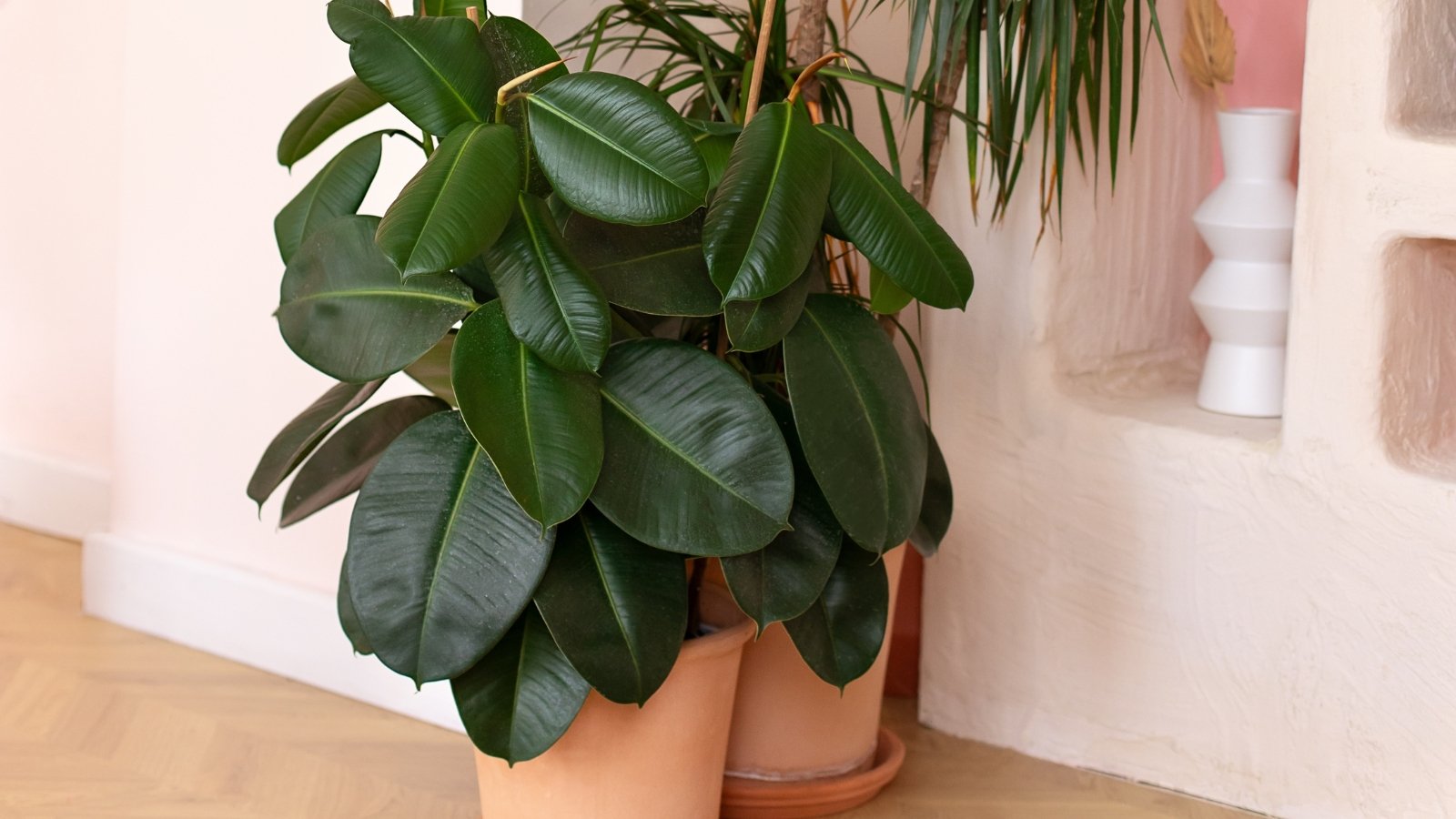
Rubber fig, also called rubber tree, is a type of ficus. Ficus are easygoing and forgiving houseplants. This lovely small tree grows quite large in its native environment but will stay smaller as a houseplant. It needs good drainage, and you should let the soil dry between waterings.
Your rubber fig will need little care in the winter. Be careful not to over-water or fertilize at this time. This one prefers elevated humidity, so a bathroom is a good place for it. Otherwise, use a humidifier. Bright indirect exposure will keep it growing and looking healthy. Too much will burn the leaves, and too little will leave you with leggy growth.
Chinese Evergreen

Chinese evergreen is a great choice if you’re worried about a lack of sunlight in your space. This lovely, leafy evergreen tolerates partial to nearly full shade and comes in a wide array of leaf colors and color combinations. It prefers moist soil, so don’t let it dry between waterings.
Low exposure, moist soil, and elevated humidity are key to caring for this tropical plant. Reduce watering slightly in the winter as it won’t go dormant, but the growth will slow.
Flame Violet
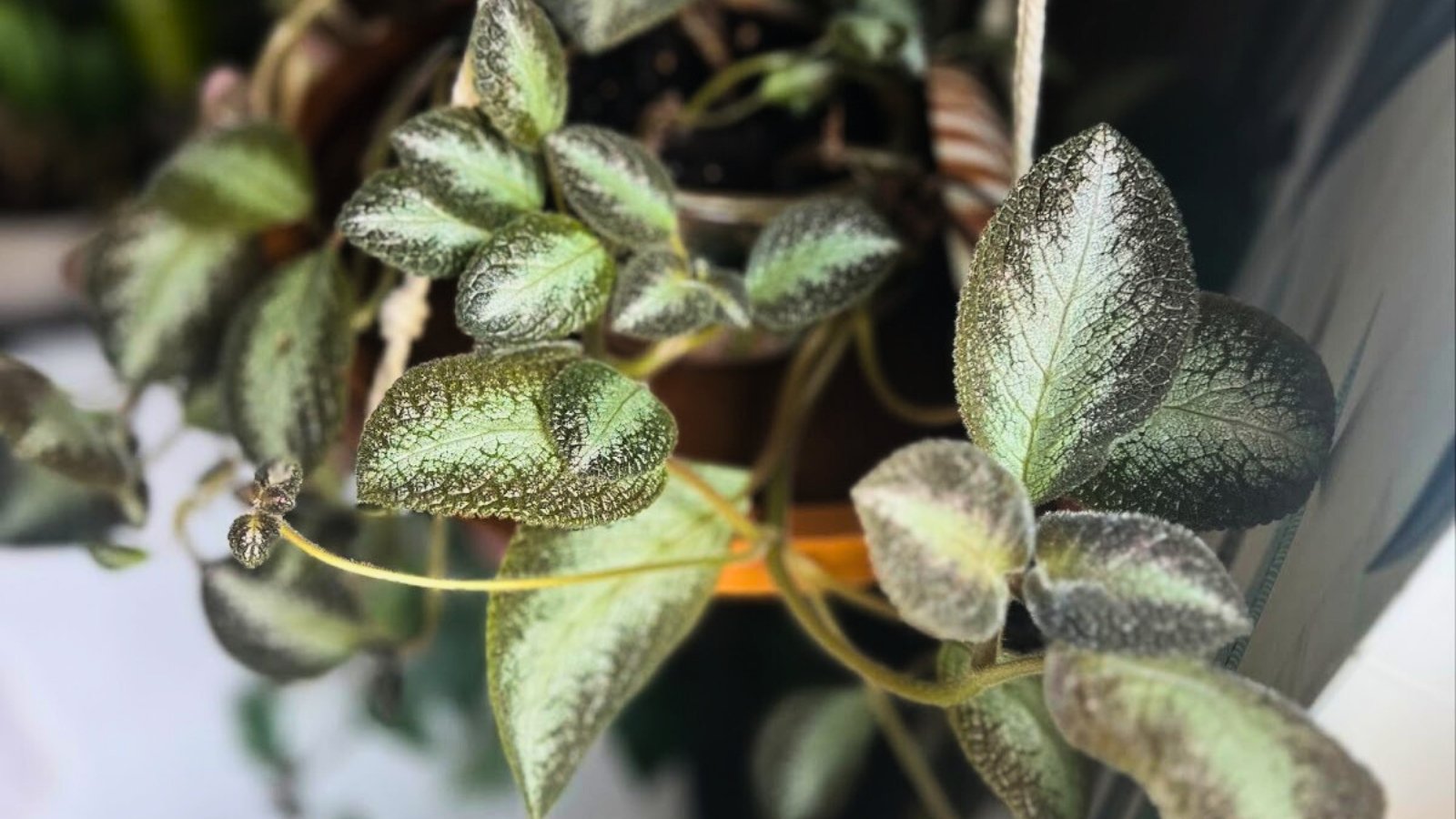
Flame violets are closely related to African violets, and they thrive with similar care. I find them to be even more low-maintenance but harder to propagate. They are native to South America, where they live under the canopy of tall trees in a humid environment. Rather than the upright growth habit of an African violet, flame violet trails.
I keep my flame violet just next to a brightly lit window. As you can see from the picture, it leans in for more light, so this one is variable. I would say partial shade is best. More sun will bring more flowers. Keep the soil moist but not soggy. It can be sensitive to tap water. If the leaf tips begin to brown, try watering with bottled or rainwater.
Peperomia
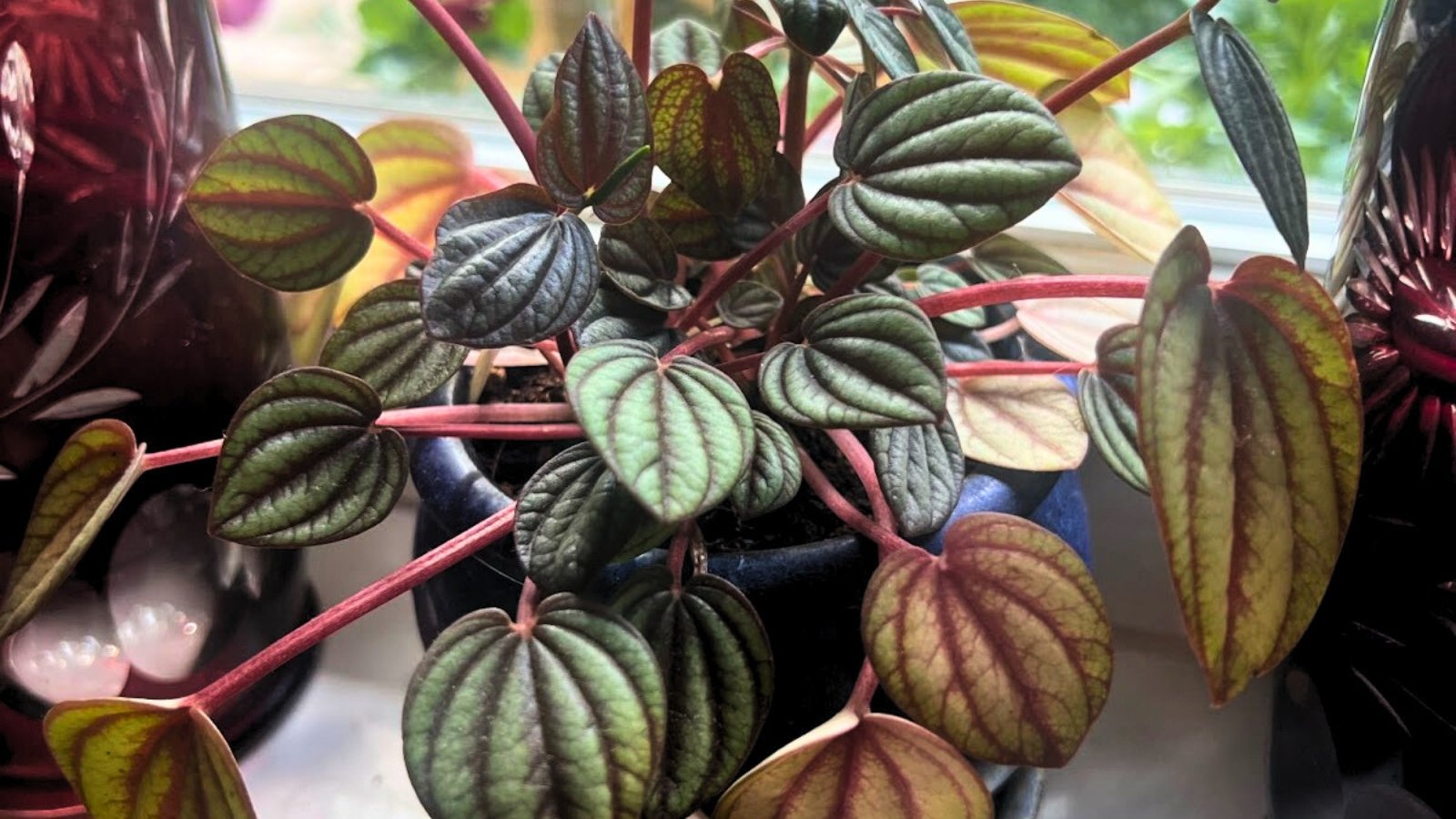
Peperomia is a large genus of tropical plants with over 1,000 species. You may recognize many types, such as watermelon peperomia or string of turtles. These like more direct sun exposure than most houseplants. Some even tolerate full sun. They bloom easily indoors, though their flowers are inconspicuous. Most folks snap them off to help the parent conserve energy.
Choose a loose potting mix and a container with good drainage. Keep the soil moist but not waterlogged. Let the surface dry between waterings. Peperomia won’t mind some extra humidity. I keep mine in the kitchen window with heartleaf philodendron and silver satin pothos.
Arrowhead Vine
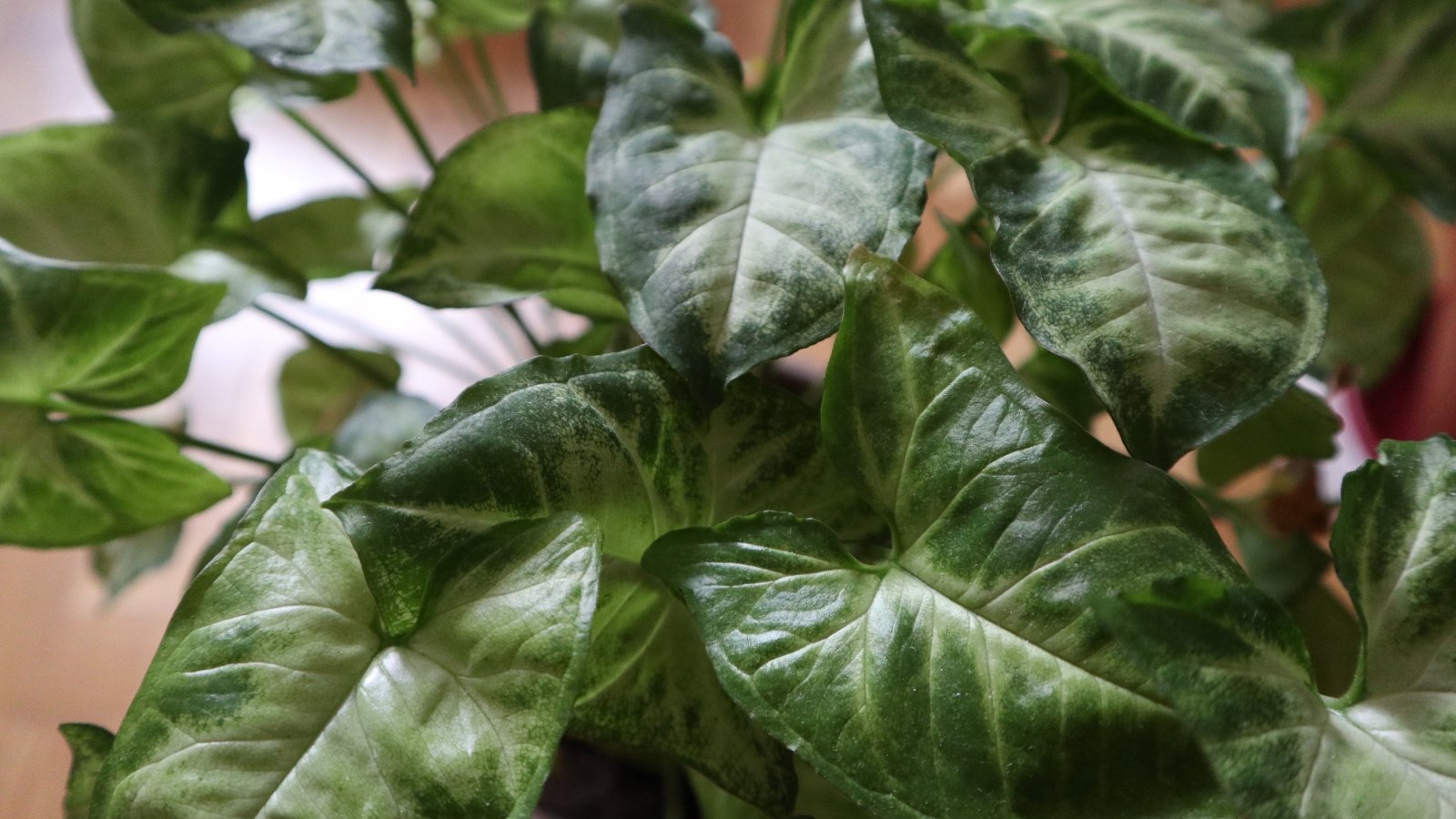
Arrowhead vines are forgiving and fast-growing houseplants. Their fun foliage comes in a multitude of colors and color combinations. Some have variegation in shades of red and pink mixed with various shades of green and white. Diffused or filtered light will keep this vine thriving, but direct exposure can burn the leaves.
Your arrowhead vine will tolerate drying out between waterings, but don’t let it go too long. It prefers lightly moist soil. High humidity is ideal, so a kitchen or bathroom is the best spot for it.
Zebrina
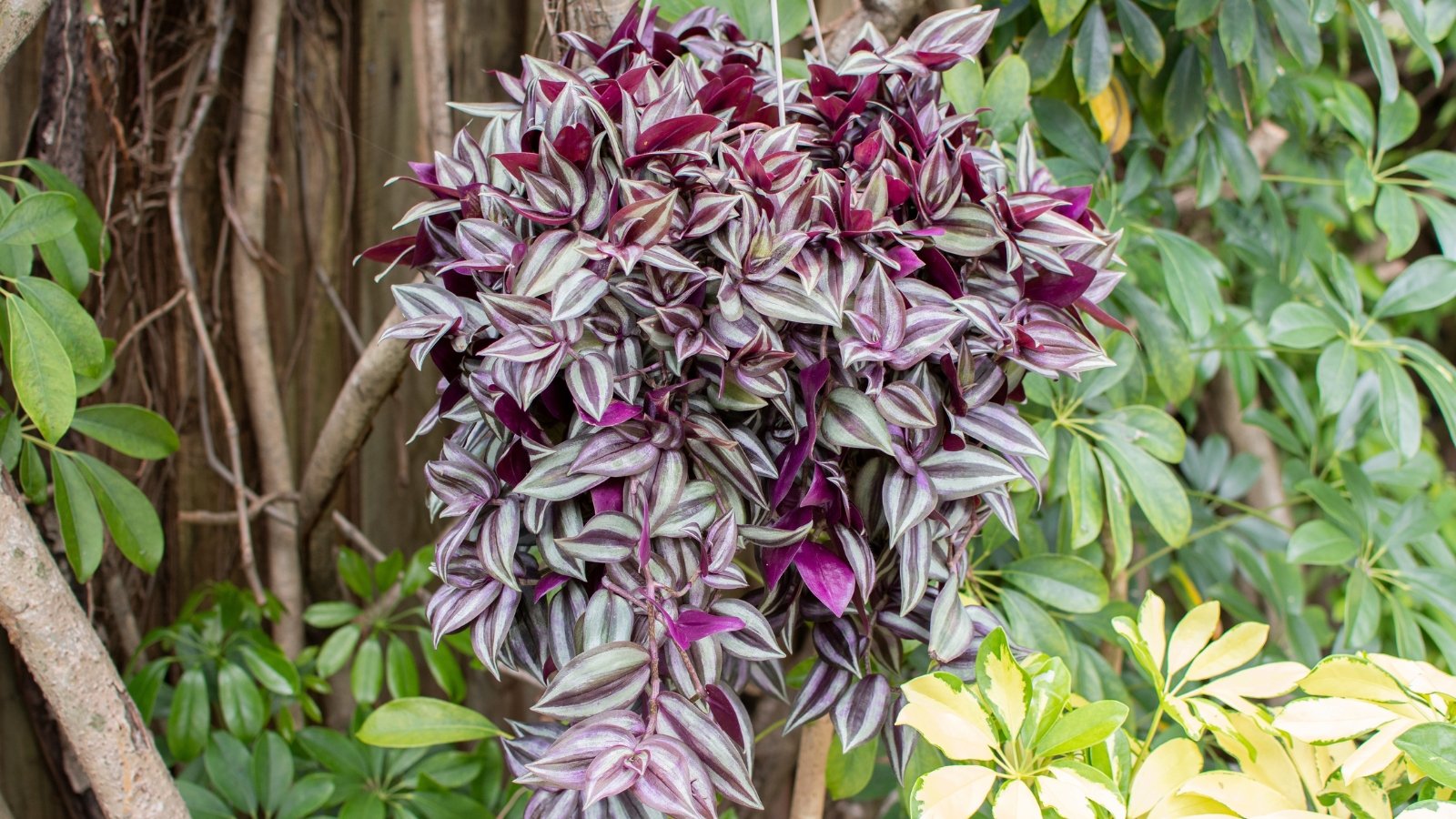
For a low-maintenance plant that looks high-maintenance, zebrina does an excellent job. Its flashy, variegated purple foliage has silvery-white variegated striping that is more pronounced in low exposure. This trailing vine grows rapidly and is exceptionally easy to propagate.
Zebrina likes moisture and high humidity. If it gets what it needs, it will produce tiny purple flowers that peek out from within the curled leaves. This one will dry out easily and may lose some foliage. It grows fast, though, and cuttings root with little to no effort.
Air Plant
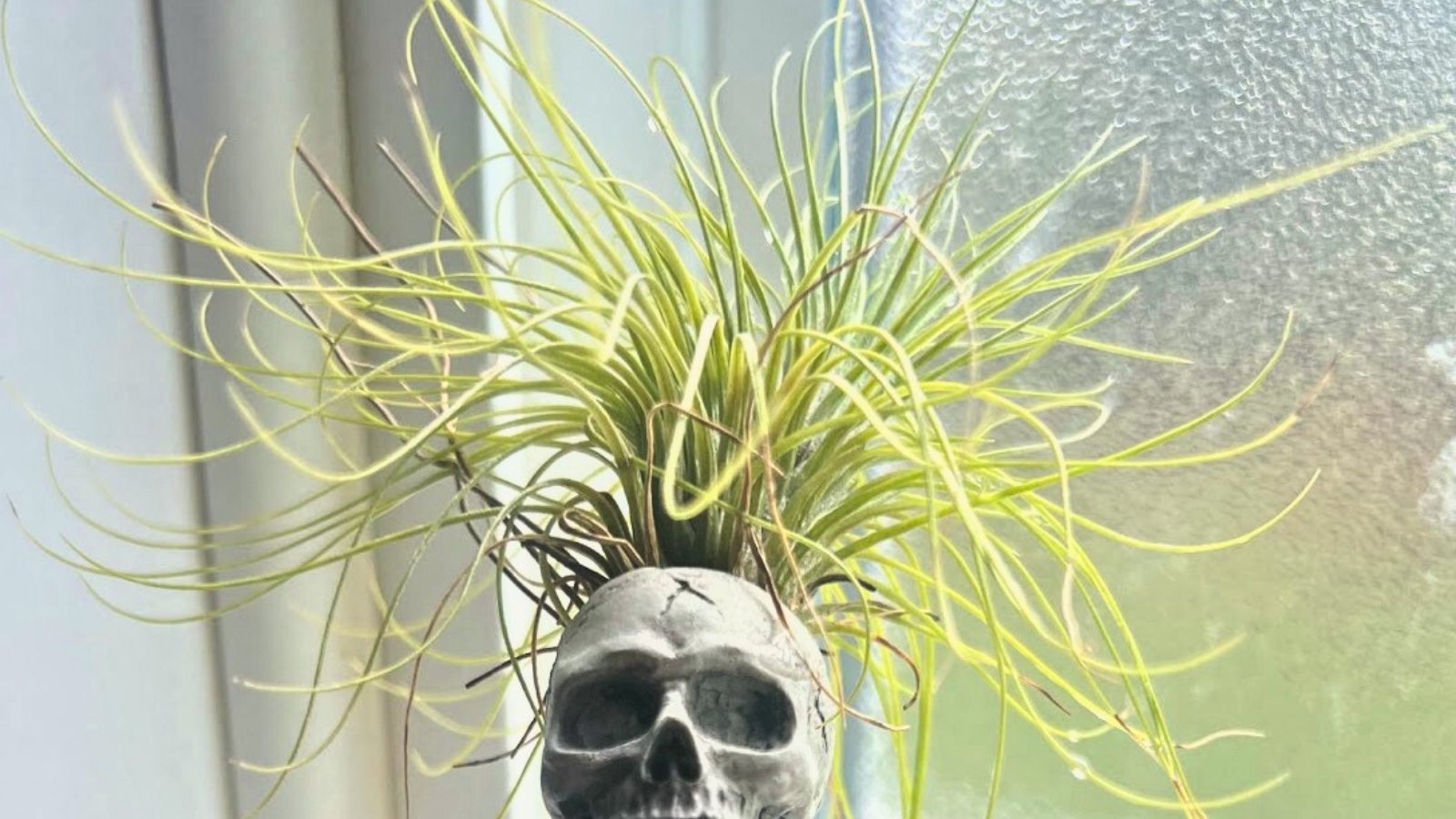
These are fun to experiment with, as they don’t need soil, and you will rarely have to water them if the air is humid enough. I have one in my shower window where it has lived quite happily for three years. You can tie these to a piece of wood or find another display receptacle to suit your taste.
I run mine under the water for a moment now and then. Otherwise, it needs no attention. Filtered sun is best, as this epiphyte grows on trees beneath the canopy. With enough sunlight, it will produce brightly colored flowers.
Chinese Money Plant
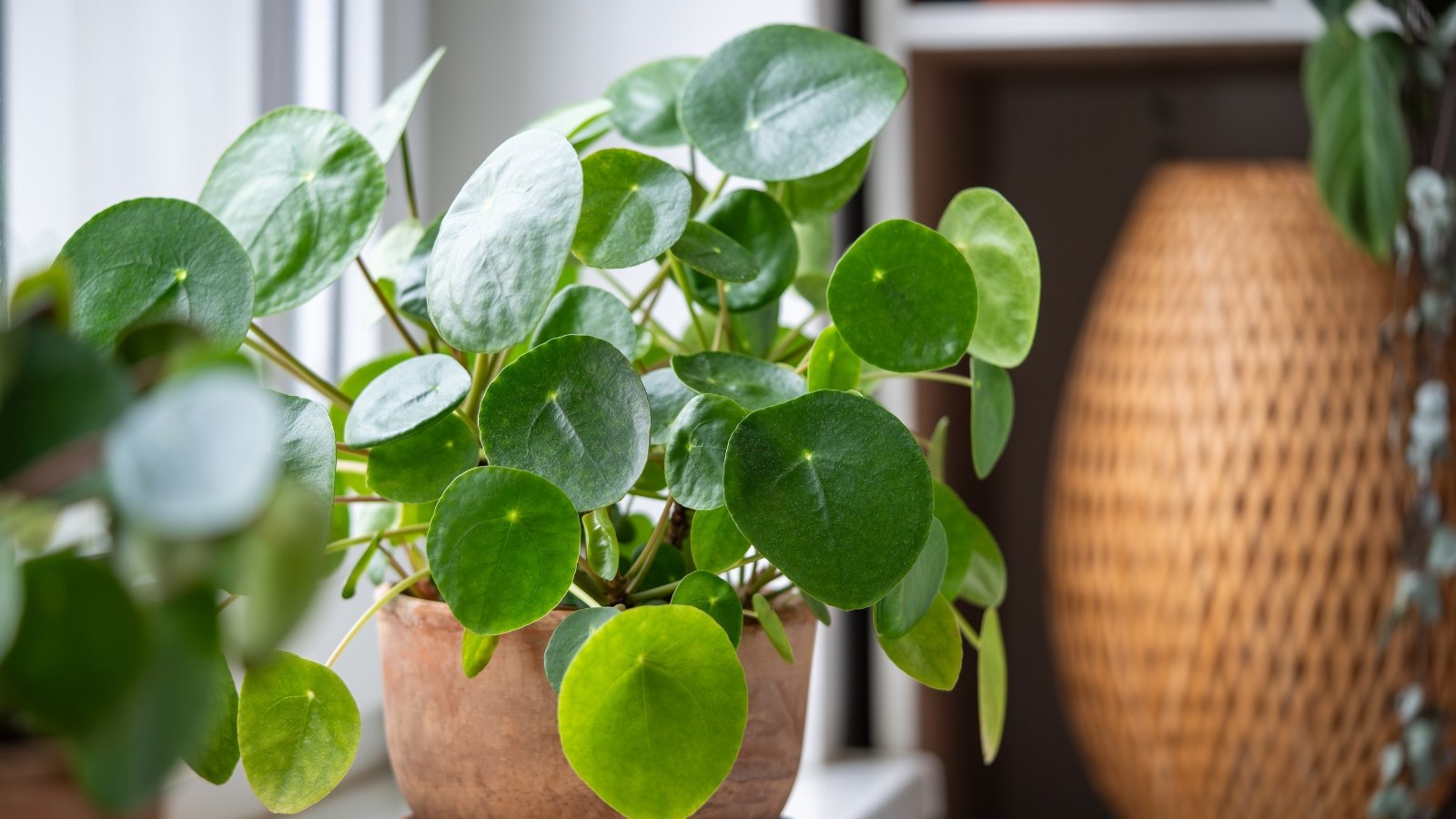
The cute and cheerful Chinese money plant has charming, coin-shaped leaves bobbing on long, stiff stems. It turns toward the sun but prefers indirect exposure. Too little sun can cause growth to become leggy.
Chinese money plant will be glad for any extra humidity it can get, but it tolerates average home environments well. Water it when the top inch of the soil is dry. Pinching the tip of the central stem will encourage bushier growth.
Echeveria
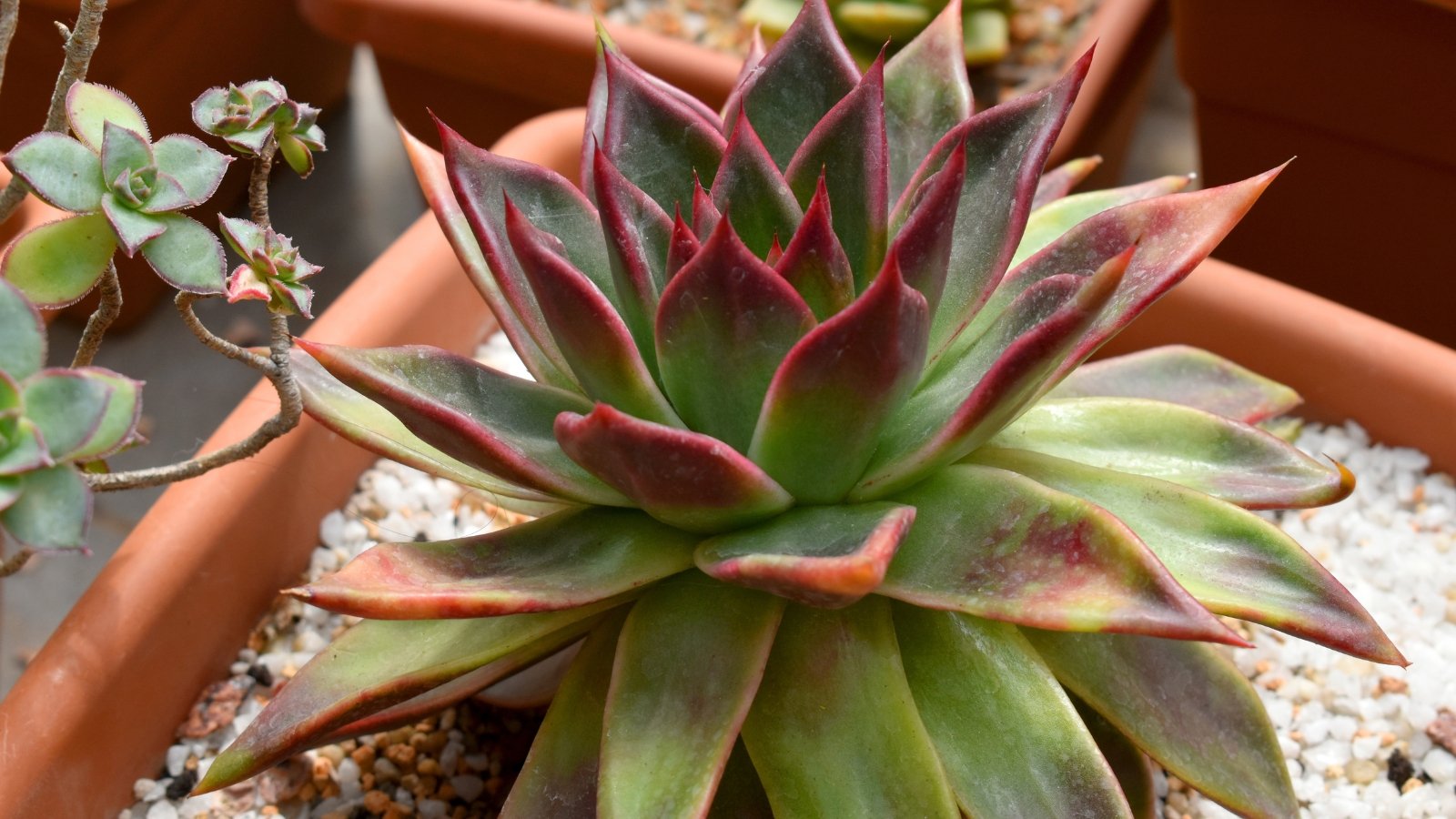
Echeverias are similar to haworthias. They like similar conditions, so they work well together in a container arrangement. They also reproduce prolifically, so be prepared to divide this one yearly. Neatly formed rosettes of fleshy leaves come in a range of shades. ‘Blue Prince’ is a beautiful variety, though ‘Perle von Nurnberg’ is my favorite.
Many echeverias will show signs of stress by flushing with purple. This can be quite beautiful, so many plant lovers expose them to a few hours of direct sun. Cold weather also brings out the purple, so sitting it near a window in winter can create some lovely color. Let it dry between waterings. It’s practically worry-free as long as you don’t over-water.
English Ivy
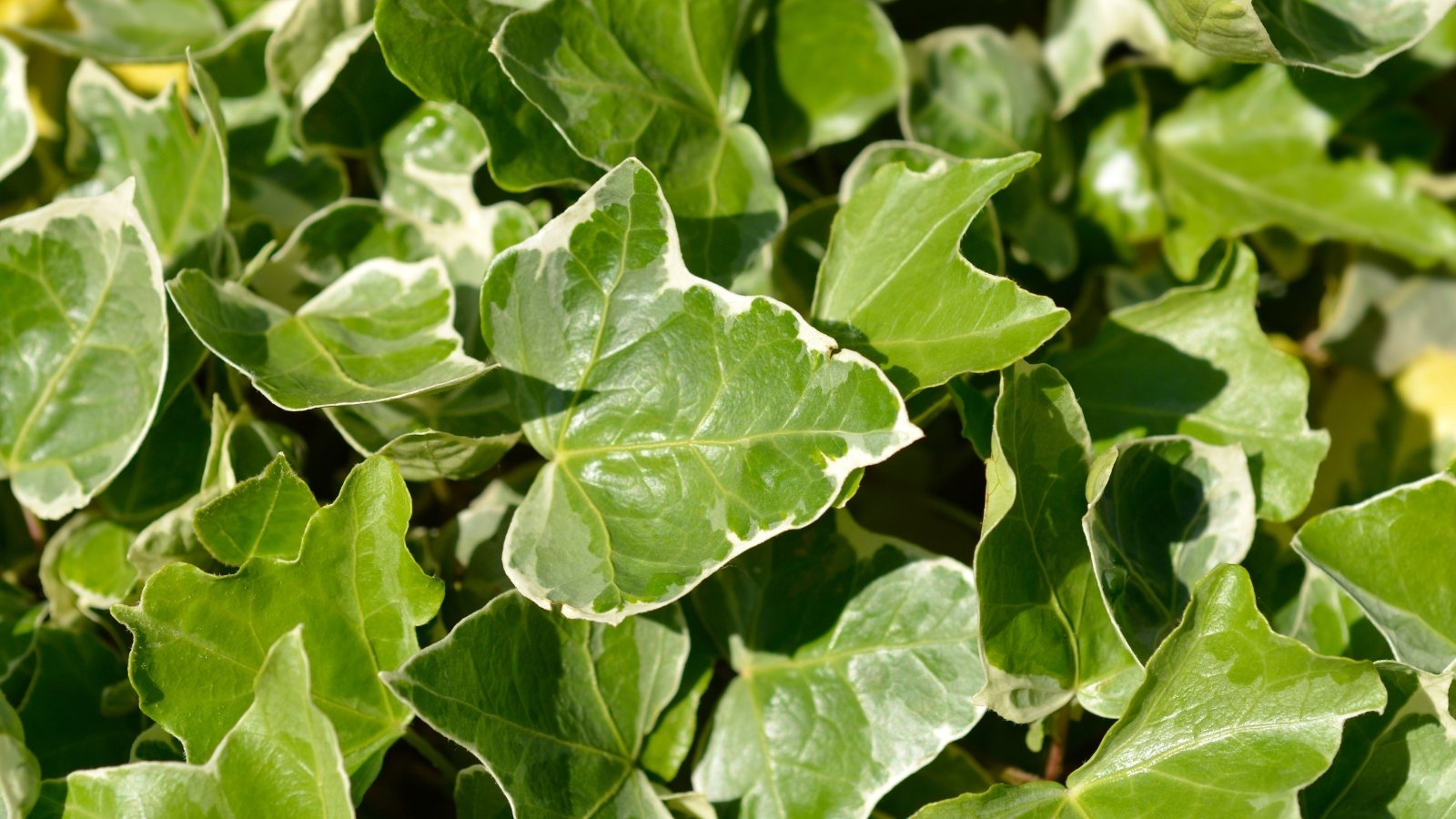
Ivy is easy to grow and can become invasive outdoors. Indoors, however, it’s easy to care for and tolerates low light conditions better than almost any other I can think of. It tolerates low light, though it prefers bright, so give it a brighter spot for a few days each month if it’s in a shaded space.
English ivy has average humidity needs and likes loose, well-draining soil. It will wilt if you neglect to water, so it has a built-in reminder for those who forget to water. Trimming vines just above a node will encourage bushier growth if your plant gets leggy.
Parlor Palm
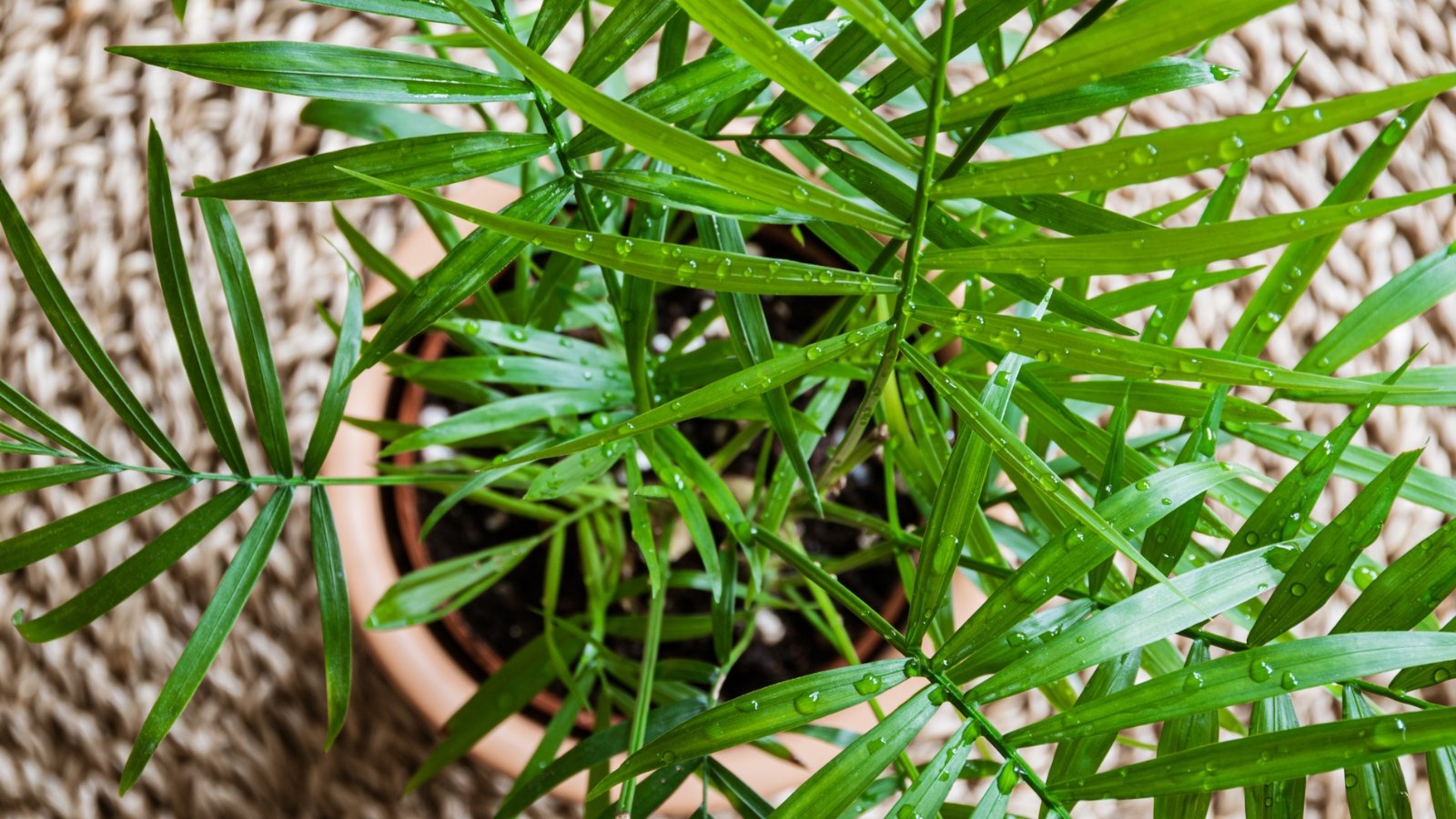
Finally, we have the charming parlor palm. This adaptable plant is great for beginners, as it will adjust to most conditions. It’s better to under-water this one than to over-water it. It likes a mild, humid climate, so it’s perfect for a bathroom window.
Parlor Palms can tolerate a variety of exposure conditions. Bright indirect light is perfect, but medium or low are acceptable, if you don’t mind slowed growth. If the tips of leaves turn brown, raise the humidity.


